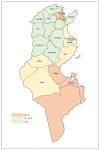The Prevalence, Genotype Distribution and Risk Factors of Human Papillomavirus in Tunisia: A National-Based Study
- PMID: 36298732
- PMCID: PMC9611589
- DOI: 10.3390/v14102175
The Prevalence, Genotype Distribution and Risk Factors of Human Papillomavirus in Tunisia: A National-Based Study
Abstract
There are limited national population-based studies on HPV genotypes distribution in Tunisia, thus making difficult an assessment of the burden of vaccine-preventable cervical cancer. In this context, we conducted a national survey to determine the HPV prevalence and genotypes distribution and the risk factors for HPV infections in Tunisian women. This is a cross-sectional study performed between December 2012 and December 2014. A liquid-based Pap smear sample was obtained from all women and samples' DNAs were extracted. Only women with betaglobin-positive PCR were further analysed for HPV detection and typing by a nested-PCR of the L1 region followed by next-generation sequencing. A multiple logistic regression model was used for the analysis of associations between the variables. A total of 1517 women were enrolled in this study, and 1229 out of the 1517 cervical samples were positive for the betaglobin control PCR and tested for HPV. Overall HPV infection prevalence was measured to be 7.8% (96/1229), with significant differences between the grand regions, ranging from 2% in the North to 13.1% in Grand Tunis. High-risk HPV genotypes accounted for 5% of the infections. The most prevalent genotypes were HPV 31 (1%), 16 (0.9%), 59 (0.7%). HPV18 was detected only in four cases of the study population. Potential risk factors were living in Grand Tunis region (OR: 7.94 [2.74-22.99]), married status (OR: 2.74 [1.23-6.13]), smoking habit (OR: 2.73 [1.35-5.51]), occupation (OR: 1.81 [1.09-3.01]) and women with multiple sexual partners (OR: 1.91 [1.07-3.39]). These findings underscore the need to evaluate the cost effectiveness of HPV vaccine implementation, contribute to the evidence on the burden of HPV infections, the critical role of sexual behaviour and socioeconomic status, and call for increased support to the preventive program of cervical cancer in Tunisia.
Keywords: HPV infection; Tunisian women; epidemiology; vaccine.
Conflict of interest statement
All authors declare no conflict of interest.
Figures






References
-
- de Sanjose S., Quint W.G., Alemany L., Geraets D.T., Klaustermeier J.E., Lloveras B., Tous S., Felix A., Bravo L.E., Shin H.-R., et al. Human papillomavirus genotype attribution in invasive cervical cancer: A retrospective cross-sectional worldwide study. Lancet Oncol. 2010;11:1048–1056. doi: 10.1016/S1470-2045(10)70230-8. - DOI - PubMed
-
- Bel Haj Rhouma R., Ardhaoui M., El Fehri E., Marzougui A., Laassili T., Guizani I., Boubaker M.S., Ennaifer E. Distribution of human papillomavirus in precancerous and cancerous cervical neoplasia in Tunisian women. Infect. Agents Cancer. 2021;16:52. doi: 10.1186/s13027-021-00392-1. - DOI - PMC - PubMed
-
- Ennaifer E., Salhi F., Laassili T., Fehri E., Ben Alaya N., Guizani I., Boubaker S. Type-Specific Human Papillomavirus Distribution in Invasive Squamous Cervical Carcinomas in Tunisia and Vaccine Impact. Asian Pacific J. Cancer Prev. APJCP. 2015;16:6769–6772. doi: 10.7314/APJCP.2015.16.15.6769. - DOI - PubMed
Publication types
MeSH terms
Substances
LinkOut - more resources
Full Text Sources
Medical
Research Materials
Miscellaneous

